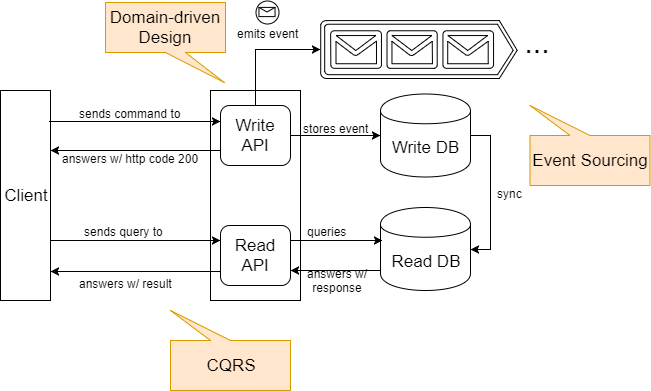I went to a great session about CQRS, Event Sourcing and domain-driven Design (DDD) on the Software Architecture Summit. The speaker Golo Roden (@goloroden) did a fantastic job selling these concepts to his audience with a great storytelling approach. He explained why CQRS, Event Sourcing and DDD fit together perfectly while replicating the www.nevercompletedgame.com for his daughter. This is what he shared with us.
Domain-driven Design
The more enterprise-y your customer the weirder the neologisms get.
We – as software engineers – struggle to understand business and domain experts. Once we understand something, we try to map it to technical concepts. Understood the word "ferret"? Guess we need a database table called "ferret" somehow. We then proceed to inform our business colleagues, "deploying a new schema is easy as we use Entity Framework or Hibernate as OR-mapper". He thinks we understood, we think he understood. Actually, nobody understood anything.
As software engineers we tend to fit every trivial and every complex problem into CRUD-operations. Why? Because its "easy" and everyone does it. If it was that easy, software development would be effortless. Rather trying to fit problems in a crud pattern, we should transform business stories into software.
That’s why we should use domain-driven design and ubiquitous language.
Golo Roden proceeds to create a view on the nevercompletedgame with ubiquitous language. So nobody asks, "what does open a game mean" and there is no mental mapping.
I won’t go into detail here, but an example can show why we need this.
- Many words have one meaning: When developing a software for a group of people, sometimes we call them users, sometimes end-users, sometimes customers etc. If we use different words in the code or documentation and developers join a project later – they might think there is a difference between these entities.
- One word has many meanings: Every insurance software has "policies" somewhere in its system. Sometimes it describes a template for a group of coverages, sometimes it’s a contract underwritten by an insurance, sometimes a set of government rules. You don’t need to be an expert to guess this can go wrong horribly.
CQRS
Golo Roden jokes, "CQRS is CQS on application level", but actually it’s easy to understand this way, once you read a single article about CQS. Basically, it’s a pattern where you separate commands (writes) and queries (reads): CQS.
- Writes do not return any values and change the state of an object.
stack.push(23); // pushes value 23 onto the stack; returns nothing - Reads return a value and don’t change the state.
stack.isEmpty() // does not change state; returns a isEmpty boolean - But don’t be fooled! Stacks are not following the CQS pattern.
stack.pop() // returns a value and changes state
Separating them on application level means: exposing different APIs for reading (return a value; do not change state) and writing (change state; do not return value *). Or phrased differently: Segregate responsibilities for commands and queries: CQRS.
* for http: always returns 200 before doing anything
Enforcing CQRS could have this effect on your application:

For synchronizing patterns see patterns like the saga pattern or 2 phase commit . For more reference see: Starbucks Does Not Use Two-Phase Commit
Event Sourcing
When talking about databases (be it relational or NoSQL) often we save the current state of some business item persistently. When we are ambitious we save a history of these states. Event sourcing follows a different approach. There is only one initial state, change requests to this state (commands) and following manipulating operations (events). When we want to change the state of an object, we set up a command. This triggers an event (that’s published so some kind of queue) and most likely is persistent in a database.
Bank account example: we start with 0 € and do not change this initial value when we add or withdraw money. We save the events something like this:
| Date | EventId | Amount | Message |
|---|---|---|---|
| 2019-01-07 | e5f9e618-39ad-4979-99a7-342cb1962266 | 0 | account created |
| 2019-01-11 | f2e98590-7795-4cf7-bdc2-1794ad39874d | 1000 | manual payment received |
| 2019-01-29 | cbf44bfc-7a5e-4514-a906-a313a6e0fb5e | 2000 | saylary received |
| 2019-02-01 | 32bc638c-4783-45b8-8c1e-bebe2b4528a1 | -1500 | rent payed |
When we want to see the current balance, we read all the events and replay what happened.
const accountEvents = [0, 1000, 2000, -1500];
const replayBalance = (total, val) => total + val;
const accountBalance = accountEvents.reduce(replayBalance);
Once every n (e.g. 100) values we save a snapshot to not have to replay too many events. Aside from the increased complexity this has some side effects which should not be unadressed.
- As we append more and more events, the data usage increases endless. There are ways around removing "old" events etc. and replacing them with snapshots, but this destroys the intention of the concept.
- Additionally, as more events are stored, the system gets slower as it has to replay more events to get the current state of an object. Though, snapshotting every n events can get deterministic maximum execution time.
While there are many contra arguments there is one the key benefit why its worth: your application is future proof, as you save "everything" for upcoming changes and new requirements. Think of the account example from the previous step. You can implement/analyze everything of the following:
- "How long does it take people to pay their rent once they got their salary"
- "How many of our customers have two apartments? How much is the difference between both rents?"
- "How many of our customers with two apartments with at least 50% in price difference need longer to pay off their car credit?"
- …
To sum it up and coming back to our initial challenge, our simple CRUD application with domain-driven Design, CQRS and event sourcing would have transformed our architecture to something like this:

While this might solve some problems in application and system development this is neither a cookie-cutter approach nor "the right way" to do things. Be aware of the rising complexity of your application, system and enterprise ecosystem and the risk of over-engineering!


